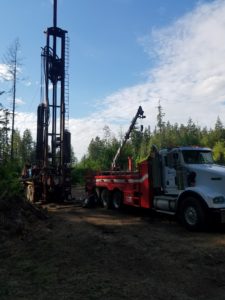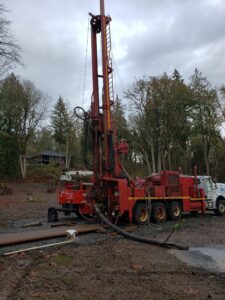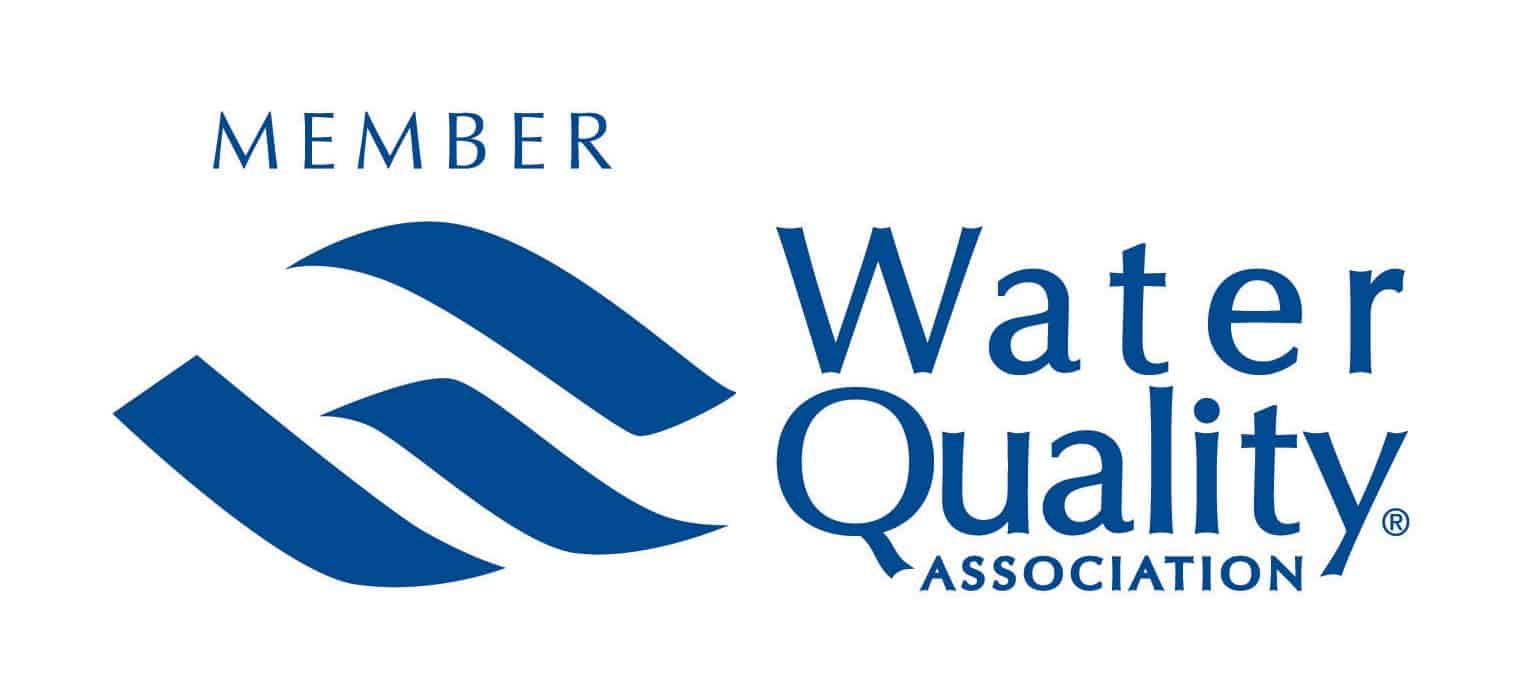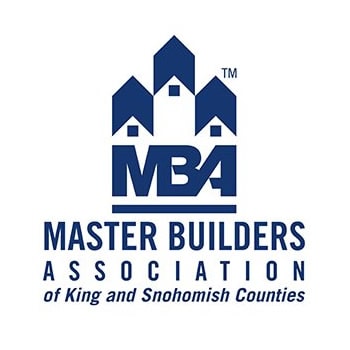The Complete Guide to Drilling A Well in Snohomish, Washington
Well drilling is the process of excavating a hole and putting a steel casing or pipe down to an aquifer underground. It sounds simple, but legally and technically, it is often quite complicated.
At JKA Well Drilling & Pumps, we have over 30 years of experience working with the various aquifers providing water to Snohomish homeowners, dairy farms, golf courses, and businesses.
Can I Drill a Well In Snohomish?
Yes! Provided your well can meet the Washington State Administrative Code well site requirements, specifically WAC 173-160-171, then you can drill a well on your property. If your property is already served by a public water system, that water system may have rules about how your new well is hooked up, the installation of a backflow prevention device, etc.
Practically, it’s difficult to fit a well on a lot smaller than about 1 acre in size – not impossible, just difficult.
Where does our water come from?
Most of Snohomish County residents living outside the local cities are supplied by water wells. The cities of Lake Stevens, Marysville, and Arlington, amongst others, are all supplied by water wells, though these are quite a bit larger than you would find in someone’s backyard.
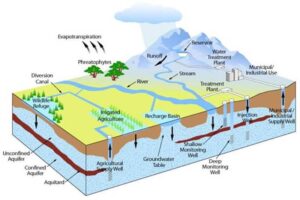
Groundwater Model, State Department of Ecology
When rain falls in the Cascade Mountains, not all of the water flows off into the rivers. Some water will be turned into ice and snow and becomes part of the snowpack that salmon and surface water supplies so desperately depend on (City of Everett and Seattle, for example). Most of the water percolates down into the ground and travels down to the ocean through underground aquifers. Aquifers are typically sorted sands or gravels that have open porous space between the sand/gravel particles that are filled with water, but some are in fractured bedrock. Examples of bedrock aquifers can be seen when traveling the mountain passes – look for cracks in the walls of rock that were dynamited for the highway to pass, and you’ll often see water pouring out of the mountain – this is an opening into a fractured rock aquifer. Some aquifers are so small as to not really even be called an aquifer and are technically known as aquitards.
Well Siting
Well site selection in Snohomish changes based on what type of well you’re having drilled. Call us today and we can refer you to the right professional to site your water well, or provide well siting services, as able. Below we’ll go through the different types of wells and how they are sited.
New Domestic Wells, Single Family
Single-family domestic wells are designed for serving one home/property. These wells are typically sited during the septic design phase of your lot development, and the septic designer will typically ask you where you want the well.
If you’re not planning on installing a septic system/building a structure, the well can be sited and drilled by a Washington State Licensed Water Well Driller. We highly encourage you to have a septic designer at least look at the soils on the property, so that the well isn’t constructed in the best location for placing a septic system at a future date.
Replacement Wells (1 or 2 connections)
Snohomish County does NOT require approval of the site selected for a replacement well. Call or email us today and a licensed water well driller can meet you on your property to discuss where a well can be best constructed. The new well will be required to meet Washington State Administrative Code for well site requirements, specifically WAC 173-160-171.
New Shared Wells (2 connections)
Shared wells in Snohomish County are treated relatively the same as a single-family well, except that you’ll need to follow the County’s guide for Two-Connection Well Requirements. Both properties will require a properly sited and Health Dept. approved well site, and a recorded document will be necessary showing the existence of the shared water system, an easement for access to the wellhead and well house, who owns the water system, how it’ll be funded and managed, etc.
For replacement wells, site approval will only be necessary if a new water system is created and/or the terms of the easement/agreement change.
Group B/A Wells (3+ Connections)
Group B or Group A water systems, public water supplies, are required to have all well sites sited by a septic designer or a professional engineer, and then approved by the local Department of Health. We can provide the appropriate referral, as necessary.
Community water systems are generally required to maintain a 100-FT radius zone of pollution control around the well. In other words, no potential pollution sources may be located within that 100-FT radius circle centered on the well.
If you’re currently managing a community water supply and are having production issues, an emergency replacement well can be sited and fast-tracked, if necessary.
Agricultural, Irrigation, & Stock Water Wells
Snohomish County does NOT require approval of the site selected for an irrigation, stock water, or agricultural well. Call or email us today and a licensed water well driller can meet you on your property to discuss where a well can be best constructed. The new well will be required to meet Washington State Administrative Code for well site requirements, specifically WAC 173-160-171.
Well Witching or Dowsing
Many people put stock in ‘water witching’ or ‘dowsing’ for locating water on their property. We’re not going to say that it does or doesn’t work, but we’ve never run across any evidence that it conclusively works. The United States Department of the Interior through the USGS has articles about dowsing, and a number of other scientific bodies have anything from brief articles to in-depth studies looking at the evidence and science to prove if Dowsing is a real skill or ability. In fact, if you can pass a triple-blind test, there’s a $1 million prize – but in the decades it’s been offered, nobody has claimed it. If you have access to the abilities or materials necessary, give it a shot, it can’t hurt.
How Much Water Do You Need?
Most domestic wells have a 10 GPM series well pump and an 80-gallon pressure tank that’ll store about 20 gallons of water between pump cycles. This means you have about 20 gallons of water between when the pump turns off and back on again, and it allows for peak demand events (someone is showering, the dishwasher is going, and the laundry is running, then someone flushes a toilet).
If you have higher flow fixtures planned (Roman fill tubs, multi-headed showers, custom sinks, irrigation, etc) then a higher flow pump or a constant pressure system is likely desirable.
How Deep Does the Well Need To Be?
Simply put, the well needs to be as deep as it needs to be to intercept an aquifer. The problem is that nobody can really determine how deep that actually is until a well is drilled. The best way you can estimate how deep the well may need to go is to use the Washington State Department of Ecolgoy’s well reporting database to look up neighboring wells. Do note that this database is not 100% – only about 3 out of 10 wells are properly recorded with the State. If the neighbor’s wells are all 60-80 feet deep, you can guess your well will be too. If the neighbor’s wells are 60, 80, 200, and 400 feet deep, this presents a lot more difficulties in determining how deep your well may go – it’s probably best to budget for the worst-case scenario and hope for the best.
Site Setup and Rig Access
Site construction for drill rig access & setup is often needed in Western Washington in all but the driest of months and flattest properties. Drilling rigs weigh as much as concrete trucks and are around 35-40 feet long, depending on the rig, with a secondary large truck bringing supplies, well casing, and tools to the job.
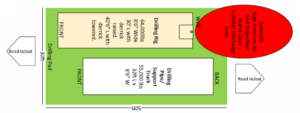
Variation of drilling rig and site setup plan
The above shows one of our recommendations for site setup. Note that this is only ONE of our 4 recommended site configuration(s) and the construction must obviously be tailored to each site individually. We do NOT provide the services to complete this work, but any qualified excavation contractor is more than able to do so (check out our referrals list). Permits may be necessary for this work, depending on the jurisdiction. The drill pad needs to be structurally capable of withstanding up to 200,000 lbs of equipment/load being placed on them during the drilling process, and reasonably level (no more than 12 inches out of level end to end).
Drill Baby, Drill!
Once drilling rigs are mobilized to the job site, they are set up and drilling often begins immediately. Shallow wells can often be completed in one day, while deeper wells can take 2-5 days to complete, some even longer if adverse drilling conditions are encountered. Once the driller finds water, a determination will need to be made as to whether a screen should be installed. A screen assembly is fabricated on site using a wire-wrapped well screen and a Figure K packer, then it is pushed to the bottom of the well casing telescopically to be exposed to the aquifer – this creates 10x more surface area for water to enter the well, and reduces the influx of sediment into the well. While a screen is often desirable, it is not always required. Once the well is developed by pumping air into the well to remove sediment from the aquifer, the drilling machinery is mobilized off the job, and the driller completes a Water Well Report for filing with the Department of Ecology. Upon completion of payment for the work, a copy of the Report will be provided to you, and a pump can be installed in the well.
Please take a moment to check out our YouTube channel at www.youtube.com/jkawelldrilling.
Submersible Pump, Testing, and Water Quality Analysis
We typically will provide an estimate for a permanent pump installation prior to starting the drilling work. Once drilling is completed, this estimate is re-evaluated to see if it matches the dimensions of the well and/or any changes the Owner may have requested. Upon approval of the new estimate, a pump installation crew from JKA will be scheduled to install the pump and perform any necessary testing that the County requires. Typically, water test results take 2-4 weeks to be returned by the laboratory.
At a minimum, JKA recommends a minimum pumping test be performed on all wells, in which the water level in the well is recorded as the well is pumped, this is known as a Drawdown Test. Water samples, if necessary, can be taken at the conclusion of this testing, provided water clarity or turbidity is reasonably low. Some wells must be pumped for a more extended length of time in order to get the water clear enough to get a representative sample for testing, in which case a generator will need to be provided.
Many counties do not require the entire EPA drinking water list to be sampled – Snohomish has an 18-item list for inorganic samples, and at least one bacteria sample. If cost isn’t an issue, we recommend that we collect the bacteria sample and a Complete Inorganic Compounds sample, for a total of 33 analytes. This covers the EPA’s primary and secondary drinking water contaminants list, including Nitrates, Lead, Mercury, and Arsenic, amongst others. However, our estimate likely only includes the minimum required by Snohomish County.
We can quote a pumping test using our company-owned pumps, which allows you to minimize your sunk costs into the well prior to determining water quality (Arsenic presence/absence), can allow you to put the majority of the water systems costs into your construction lending package, and allows us to design the most efficient permanent pump system be determining exactly how the well reacts under various flow rates & loads. With the data gathered from a proper pump test, we’ll know exactly how hard we can push the well for the design of the rest of the water system, including if we can draw fire flow straight from the well allowing large savings if we don’t need to build out a large storage tank and booster pump system. If this work is completed, a submersible pump will be installed during step #5, below.
A special note about Arsenic: is often found in Snohomish County at levels that range from 1 ppb to over 200 ppb. Usually, it’s found below 50 ppb, and occasionally at 50-100 ppb, only rarely above that. If found between 0.01 and 9.99 ppb, a Notice: Well Water Arsenic Disclosure will be recorded against the property by you as part of the building permit process. 10 ppb to 50 ppb can be treated using a Point of Use filter installed at the kitchen sink for just drinking water. 50 to 150 ppb can be treated with a Point of Entry filter system that filters all the water entering the house. Both systems will require that the entire treatment system be engineered by a professional engineer (see our referrals list).
Contact JKA Well Drilling & Pumps in Snohomish
Your water system is an important thing, and the heart is your water well. Drilling a well is often an expensive endeavor, so you will want to make sure the job gets done right the first time. Don’t be left without clean water to drink and thousands of dollars in repairs. Wherever you’re located in Snohomish County, we know how to drill the best well for your property.
At JKA Well Drilling & Pumps, we specialize in everything related to well drilling, water pumps, water treatment, water testing, and more. If you are thinking about drilling a well on your property, call our experts.
